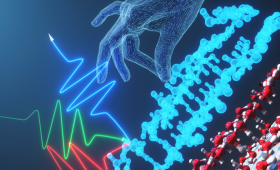LLNL and Verne have demonstrate a novel pathway for creating high-density hydrogen.
Science and Technology Highlights
This episode of the Big Ideas Lab podcast takes a deep dive into how the Innovation and Partnerships Office facilitates tech transfer at LLNL and some of the most impactful success stories over the years.

A recent study from LLNL used a combination of spectroscopy, simulation and machine learning to examine the surface of ice.
New research, published in Nature by a team including LLNL scientists, introduces an experimental technique to constrain the size of the neutrino’s wavepacket.
New research from LLNL aims to tackle corrosion by predicting failure and informing the design of better materials.
LLNL, Arizona State University and Michigan State University dive deep into uncovering the compositions of 70 exoplanets through LLNL’s Computing Grand Challenge Program.
LLNL researchers and neurotechnology company Canaery develop an advanced nose-computer interface (NCI) capable of enhancing the ability of scent-detection animals.
In the evolving fields of materials science and 3D printing, LLNL engineers are exploring novel ways to create materials and structures that adapt and respond to their environments.
LLNL researchers, the InQubator for Quantum Simulations and the University of Trento develop an algorithm for a quantum computer that accurately simulates scattering.
LLNL engineering researchers achieve breakthroughs in multi-material additive manufacturing (3D printing) through the power of capillary action.

